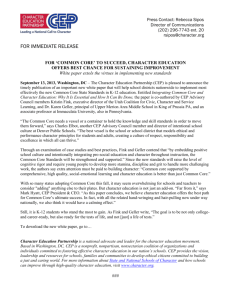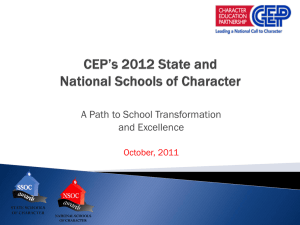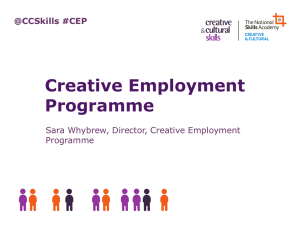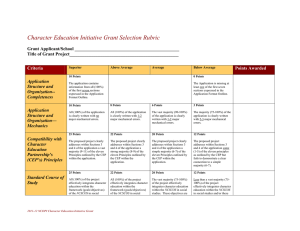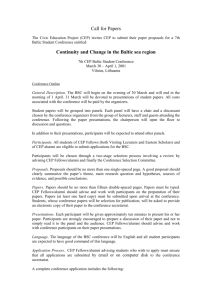Part 2
advertisement
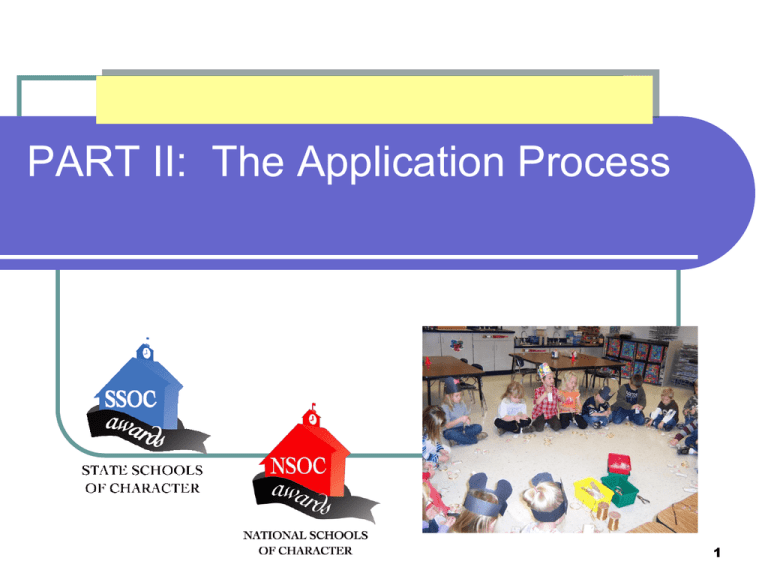
PART II: The Application Process 1 Getting Started Gathering documents you will need: Go to CEP’s website: www.character.org Print the NSOC/SSOC application guidelines Print and REVIEW the revised 11 Principles (Sample application is available on website.) 2 CEP’s Eleven Principles: What is quality character education? Effective character education: Principle 1: Promotes core values. Principle 2: Defines “character” to include thinking, feeling, and doing. Principle 3: Uses a comprehensive approach. CEP’s Eleven Principles: What does a school with quality character education look like? Principle 4: Creates a caring community. Principle 5: Provides students with opportunities for moral action (service learning). Principle 6: Offers a meaningful and challenging academic curriculum (performance character). Principle 7: Fosters students’ self-motivation. CEP’s Eleven Principles: Who should be involved in character education? Principle 8: Engages the staff as an ethical learning community. Principle 9: Fosters shared leadership. Principle 10: Engages families and community members as partners. CEP’s Eleven Principles: How are we doing? Where do we go from here? Assessment should guide the process! Principle 11: Assesses the culture and climate of the school. Getting Started Enter information about your school, date your initiative began, demographics, etc. This data helps track your application and aids communication. After you hit “submit,” print the one-page Cover Sheet. Make it the cover of your application. Putting it all together: The Narrative with Supporting Evidence: You have 25 pages (30 for districts) for a narrative and inserted supporting evidence (at least ¼ text and ¼ artifacts) Make sure your presentation is readable Use 1 inch margins, 12 point type, Times New Roman font Double space: use only one side of the paper Number pages 8 Begin with page 1 An overview of your school or district in terms of character education It answers the questions: What are your character education goals and what is so special about your school or district that it deserves NSOC recognition? It should include: How/when you agreed upon your core values What you are trying to accomplish Why you are doing what you are doing What feature of your initiative is most exemplary 9 Helpful Hints Write a paragraph (or more) for each principle and include examples that address the scoring items and key indicators Insert artifacts (supporting evidence) within your narrative Number each section by principle Only mention information once even when it overlaps principles Provide qualitative and quantitative evidence. Show that you have gathered data and acted upon it. 10 Supporting Evidence Insert documents that lend evidence (artifacts) directly into your application. Examples: Data on positive behavioral or academic changes School climate survey results with before and after comparisons Mission statements and school mottos Examples of student work or student reflections Lesson plans or assignments that integrate character education Articles from newsletters or newspapers Documentation of staff development 11 The Importance of Principle 11 Shows character education has made a difference. Provide specific qualitative and quantitative evidence. Provide full data and analysis from surveys or other measurements. Use numbers, not percentages, when reporting changes in student behavior. Demonstrate that you have gathered data, reflected upon it, and then acted. 12 Guidelines for Inserting Artifacts Clearly label each item Be mindful of reproducibility Do not reduce items to less than 10 pt. (except news articles) Include only one item per insertion Date newspaper articles Use photographs judiciously Do not include original documents 13 In Lieu of Inserting Artifacts Use an appendix format See application guidelines for specific directions 14 Self-Assessment Score Sheet Have stakeholders score your initiative individually using the Eleven Principles Scoring Guide. Prepare a compilation (average) of your scores as the last page of your application. Use the Excel score sheet from CEP’s website, or use the score sheet page of the 11 Principles. 15 Background Information Include on the bottom of the score sheet: AYP explanation, if necessary Who completed the self-assessment Who contributed to the application Information about previous NSOC/SSOC applications 16 Additions and Tips INCLUDE: Changes since the last application Leadership efforts Explanation of commercial programs Note reviewers may visit your website for additional data. 17 Two Formats 1. Mail 3 copies OR 2. Make a PDF of your assembled application, including your Cover Sheet and Self-Assessment Score Sheet, and submit the PDF via email. Be sure file size is not too large (varies – usually no more than 8 MB). Submit to state sponsor if from a participating state. Otherwise submit to CEP. Due date: December 1, 2010 18 Promising Practices Unique and specific character education strategies and programs that address one or more of the 11 Principles Applications are due March 15, 2011. (April 15 for SSOC/NSOC applicants) CEP features winning practices in the annual NSOC publication and on its website, where educators may search for ideas that work. NSOC/SSOC applicants receive special consideration. Questions? Contact Janice Stoodley janice.stoodley@character.org (1-800) 988-8081 or (202) 296-7743 Application guidelines and CEP’s 11 Principles are available at www.character.org Character Education Partnership 1025 Connecticut Ave., NW, Suite 1011 Washington, DC 20036 20 CREDITS… Adapted from PowerPoints developed by Eileen Dachnowicz CEP Screener, Site Visitor, Trainer, and NSOC Book Author © Character Education Partnership, 2010 21
